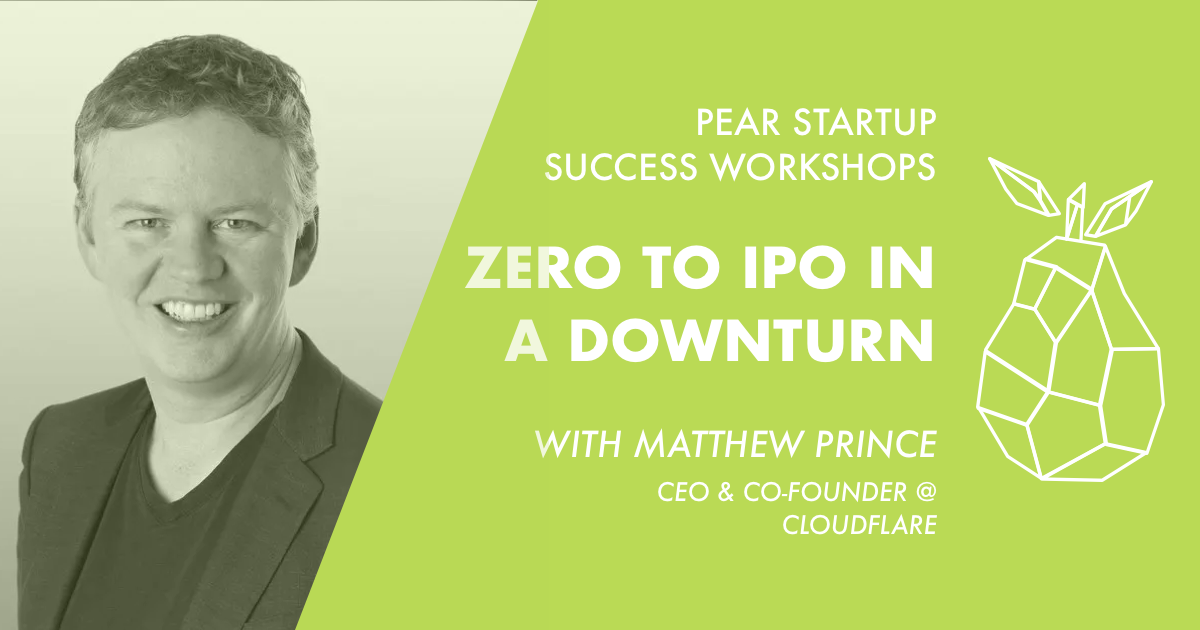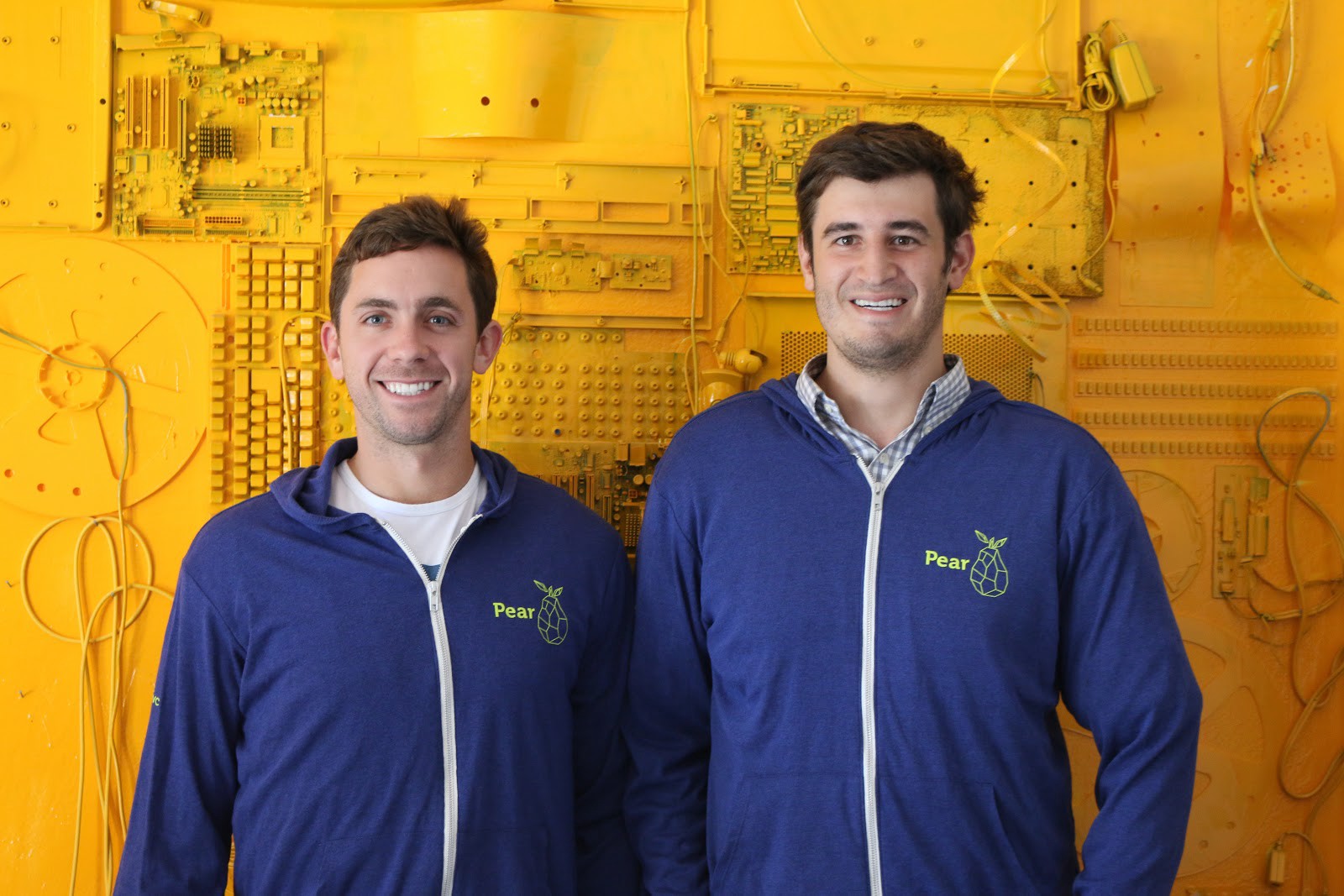This is a recap of our partner Ian Taylor’s April 27th fireside chat with Matthew Prince, founder and CEO of Cloudflare. Watch the full talk at pear.vc/speakers, and RSVP for the next.
Cloudflare was born in 2009 during the Great Recession, and recently went public last year. As we continue to make our way through the economic downturn caused by COVID-19, we’re looking to Matthew Prince, Co-founder and CEO, for insights and advice on starting a company during hard times.
What a recession teaches you Don’t start a company with your friends Figure out your unfair advantage in hiring
What A Recession Teaches You
As many have said before, some of the greatest companies have come out of recessions. Matthew’s business school classmates included the founders of Rent the Runway, ThredUP, and Tough Mudder. Matthew thinks there are two reasons for that.
“If the economy had been roaring, and if everything had been going really well, I’m not sure that Michelle and I would have ever taken the risk to start a business. At some level, adversity makes you start to think about other paths that you can take,” says Matthew.
Michelle, Matthew’s co-founder, had completed her MBA summer internship at Google. Traditionally, if interns did well over the summer, they could expect an offer to return after their MBA. That year, the recession meant that Google was not making offers to anyone.
The second reason great companies come out of recessions is that recessions force a frugal attitude.
“At some level, your job as the founder of a company is to not run out of money. There are lots of ways to not run out of money. You can generate tons of revenue. You can raise a whole bunch of money. But one of the best is just not to spend a lot, and to be really frugal with the resources you have,” says Matthew.
Building a company during a time of crisis made Matthew and Michelle incredibly cognizant of every dollar they were spending. It also forced them to focus on pushing forward instead of getting caught up in unnecessary details or wasting time running up and down Sandhill Road.
“We basically pitched one venture capitalist who we thought was the right initial investor. We had a relationship with another VC firm that didn’t typically do early stage deals as well,” said Matthew. “But we didn’t optimize.”
Matthew continues: “We said, ‘Yeah, okay, you’ll give us a couple million bucks,’ which seemed like a huge amount of money at the time. We basically did the deal on handshake. In retrospect, we could own a lot more of the company. The biggest slug of equity we gave up was in that first round, but it just so doesn’t matter if these things are successful.”
Don’t Start A Company With Your Friends
Matthew Prince’s first company was an anti-spam product, and he co-founded the company with his friends from junior high school — they’d all had lockers next to each other.
“That is about the worst possible way you can choose who your co-founders are,” Matthew says emphatically.
While his co-founders were great people that he respected, the big problem was that there was no diversity in their skill sets.
“If there aren’t natural divisions that make it clear whose job is what, then when you get to hard decisions, you end up spending all your time just fighting over what the right answer is and you don’t actually get anything done. If you then resort to hierarchy where I say, “Well, I’m the CEO, therefore this goes, that doesn’t make the other people feel really good, because they could have just drawn different straws and been reordered in different ways. So we fought like dogs,” Matthew recalls.
Though Matthew and one of his co-founders are close friends again nowadays, there was a point where they didn’t speak for several years after the experience.
It is a far better strategy to look for complementary co-founders.
“If you’re starting a company, there’s this huge surface area that you’ve got to build a team to cover. With your founding team, you want it to be like a Venn diagram where there’s just enough overlap that you guys can communicate. But mostly you’re just trying to cover as much surface area as possible.”
In those early days of Cloudflare, Michelle focused on process and operations; Matthew focused on vision, marketing and sales; and Lee focused on tech.
“I remember early on, one of the things that really mattered to Michelle — she was like, ‘I want to be on the board.’ I went to Lee and I was like, ‘Do you want to be on the board?’ He was like, ‘Why on earth would I want to be on the board? I just want to write code.’”
It made for a strong, foundational group, and Matthew believes it’s a crucial set up from the beginning.
“One of the questions that we get all the time is, ‘Gosh, how did you guys split up responsibility?’ I try not to say this when someone asks it, but immediately my thought is, you have the wrong co-founder. Because if it’s not 100% clear from day one, it’s only going to get harder every day that passes.”
Figure Out Your Unfair Advantage In Hiring
Recruiting is always the hardest thing you have to do as an entrepreneur, and it’s likely the biggest challenge you’ll face when starting a company during a recession. Workers are less palatable to taking on risk during hard times.
Still, it’s the one thing you as the CEO cannot “fire yourself” from.
“Companies are just collections of the people who join them, so there’s almost nothing that you can do that’s more important than just making sure you’re getting really, really, really high quality people,” says Matthew.
The two characteristics that Cloudflare tries to hire for are curiosity and empathy. Matthew defines empathy as the ability to be a good listener and the ability to change one’s mind when they hear facts that are different from what they might have assumed.
In the tough early days when nobody’s heard of you, the mindset you need to take when recruiting is to think about what you can do that gives you an unfair advantage.
For one of Cloudflare’s early hires, that meant figuring out visas.
Matthew found one of his first programmers simply scrolling through LinkedIn. They were looking for a candidate who was a low-level C and assembly programmer, and they found a profile of a person who had an incredible resume for exactly that. However, the candidate was currently working as a front-end HTML web designer.
Matthew saw an opportunity. He reached out to the candidate, pointing out that he seemed underemployed. It turned out that the candidate was a French citizen who wanted to be in the United States, and his current firm was the only one that could sponsor his visa.
Matthew offered to transfer the visa to Cloudflare, where the programmer would be able to write C and assembly. The candidate immediately accepted.
After that hire, the team went and found a great immigration attorney, and continued the strategy of looking for people who were underemployed on some kind of visa. They would then transfer those candidates’ visas over.
“You can say ‘We’re going to all make a ton of money,’ but that’s what every startup says. You have to figure out ways to get people to have a span of control of things that they really love to do, or have a mission and a purpose which really resonates,” says Matthew.
“It took us a while to figure out that Cloudflare’s mission was to help build a better Internet, but once we did, people were like ‘Yes! That’s why I work here, I like coming in and solving the hardest problems on Internet-level scale.’”
Matthew and his co-founding team made sure to be relentlessly fair to those first employees. Though half of Cloudflare’s original 8 employees eventually went on mostly to start other companies, they all came to join the team on the floor of the New York Stock Exchange when Cloudflare went public.
“It’s pretty amazing, we wouldn’t have gotten to where we were without them, so it was great to be able to celebrate there with them,” says Matthew.



